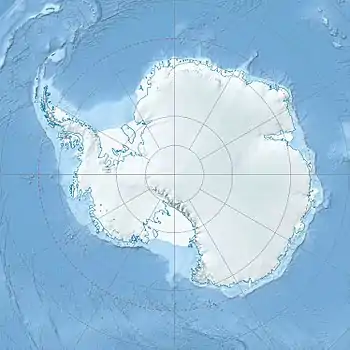Deep Lake (Antarctica)
Deep Lake (77°34′S 166°13′E) is a small elongate hypersaline lake 0.5 nautical miles (0.9 km) north of Cape Barne, Ross Island. The descriptive name was applied by the British Antarctic Expedition, 1907–09.
| Deep Lake | |
|---|---|
 Deep Lake | |
| Location | Antarctica |
| Coordinates | 77°34′S 166°13′E |
| Type | lake |
| Max. depth | 36 m (118 ft)[1] |
Deep Lake's surface temperature on average ranges from -16 to 12 °C, with only a few meters at the lake's surface exceeding 0 °C for a few months of the year during the austral summer. Lake water temperatures can fall as low as -20 °C in winter, however the lake's water column is able to remain free of ice year-around due to the high salinity (~270 g/L−1) of the lake water.[1] The archaeon Halorubrum lacusprofundi was first isolated from Deep Lake in the 1980s and is the first archaea domain member to be isolated from a cold environment.[2][3]
References
- Williams, Timothy J; Allen, Michelle A; DeMaere, Matthew Z; Kyrpides, Nikos C; Tringe, Susannah G; Woyke, Tanja; Cavicchioli, Ricardo (20 February 2014). "Microbial ecology of an Antarctic hypersaline lake: genomic assessment of ecophysiology among dominant haloarchaea". The ISME Journal. Springer Science and Business Media LLC. 8 (8): 1645–1658. doi:10.1038/ismej.2014.18. ISSN 1751-7362. PMC 4817606. PMID 24553470.
- Franzmann PD, Stacklebrandt E, Sanderson K, Volkman JK, Camberon DE, Stevenson PL, McMeekin TA, Burton HR (1988). "Halobacterium lacusprofundii sp. nov., a halophilic bacterium isolated from Deep Lake, Antarctica". Systematic and Applied Microbiology. 11 (1): 20–27. doi:10.1016/S0723-2020(88)80044-4.
- DeMaere, Matthew Z.; Williams, Timothy J.; Allen, Michelle A.; Brown, Mark V.; Gibson, John A. E.; Rich, John; Lauro, Federico M.; Dyall-Smith, Michael; Davenport, Karen W.; Woyke, Tanja; Kyrpides, Nikos C.; Tringe, Susannah G.; Cavicchioli, Ricardo (30 September 2013). "High level of intergenera gene exchange shapes the evolution of haloarchaea in an isolated Antarctic lake". Proceedings of the National Academy of Sciences. 110 (42): 16939–16944. doi:10.1073/pnas.1307090110. ISSN 0027-8424. PMC 3801024. PMID 24082106.
From DL, Halorubrum lacusprofundi, the first member of the Archaea domain isolated from a cold environment (11), has been formally described.
![]() This article incorporates public domain material from "Deep Lake (Antarctica)". Geographic Names Information System. United States Geological Survey.
This article incorporates public domain material from "Deep Lake (Antarctica)". Geographic Names Information System. United States Geological Survey.